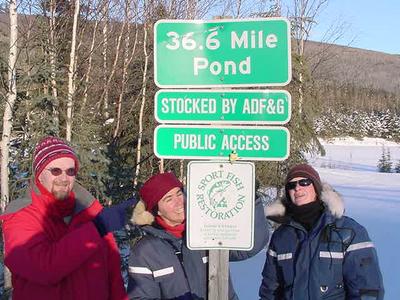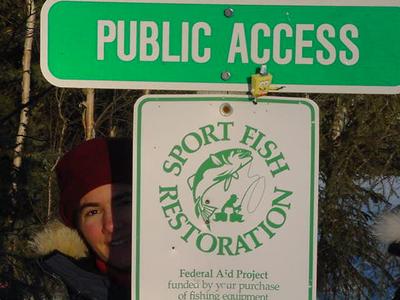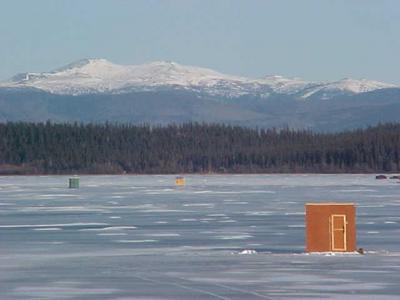
|
18 February, 2003SOMETHING "FISHY" UNDER THE ICE Although the focus of the ALISON Project is lake ice growth and decay as it relates to heat flux, today we are going to travel below the ice for a look at other ways that these ponds may influence (and be influenced by) human activity. Many of the ponds at Poker Flat Research Range have not been formed naturally. They are products of road construction and are typically only several meters deep. It is also quite likely that at least some of these ponds suffer from eutrophication, an aging process that leads to high algae content and anaerobic conditions during the summer months, when heat flows into the water. The evidence to support this is the strong, foul odor of hydrogen sulfide coming from some of the ice-depth holes that our team has drilled. A dark yellow tint in the water can also be noted at these times. It is somewhat surprising, then, that several of these ponds along the Steese Highway (ponds at mile 29.5, 31.6, 33.5, 34.6, 35.8, and 36.6) are stocked with several hundred Rainbow Trout (averaging 8.3 inches in length) during the month of June. Although one of the goals of the Division of Sport Fish is to conserve naturally reproducing populations of fish, the primary focus of the stocking programs is to provide sport fish intended for human consumption. In order for a private pond or lake to be considered for stocking it must meet several criteria: It must have no inlet or outlet stream It must have no resident fish It must have free public access. One of the serious, recent concerns among sport fishing enthusiasts, especially in the Anchorage region, is the appearance of a highly aggressive, non-native fish known as the Northern Pike. It is suspected that individuals who enjoy reeling in a fish that will fight back have illegally introduced these "alien" fish. Unfortunately these invasive fish can significantly alter the ecology of lakes that do not normally contain Pike. Pike are voracious eaters and they rapidly consume juvenile trout and Coho Salmon. Here are a few facts about Pike from the Alaska Department of Fish and Game: Pike have been known to live up to 13 hours out of water. The largest Alaska Northern Pike ever recorded weighed 38 pounds. Pike can travel long distances through interconnected lake systems. Pike have a delicious tasting white meat. 5. The "Pike Police" recommend that people in south-central Alaska go on pike-hunting expeditions and keep all of the pike that they catch. Here are a some final lake-stocking questions to consider: What will happen to dissolved oxygen levels in the bottom of these lakes as the ice becomes thicker and thicker? Are Rainbow Trout typically found in water bodies with high dissolved oxygen levels or low dissolved oxygen levels? Are small, shallow, manmade ponds the ideal habitat for Rainbow Trout? To find a complete record of stocked lakes in Alaska's south-central region, visit the state's Sport Fishing Web site at http://www.sf.adfg.state.ak.us.
Contact the TEA in the field at . If you cannot connect through your browser, copy the TEA's e-mail address in the "To:" line of your favorite e-mail package. |







